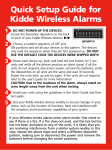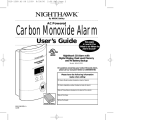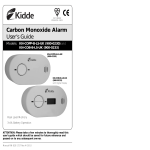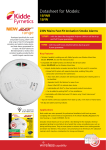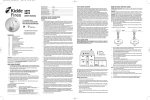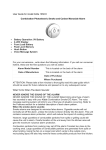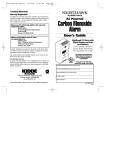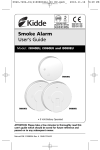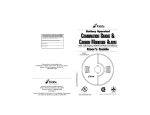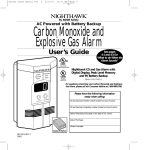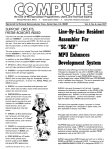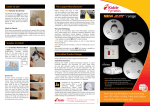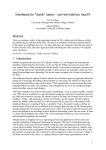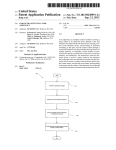Download ICO Owners manual - Budget Fire Safety
Transcript
2512-7206-00.qxd 2005.11.2 5:19 PM Page 1 Carbon Monoxide Alarm Owner’s Manual 230V Interconnectable Mains Operated Alarm with Rechargeable Lithium Ion Battery Backup 423D/9HIR CO Alarm with digital display, Peak level Memory and Smart Interconnect 423/9HIR CO Alarm with Smart Interconnect Thank you for purchasing a Kidde Fyrnetics alarm. Please read through our guide in full. This Kidde Fyrnetics CO Alarm is suitable as a single station and/or multiple station device - up to 18 alarms. It is designed for residential premises only. Lic No: KM 98848 EN50291:2001 Kidde Safety Europe, Mathisen Way, Colnbrook, SL3 0HB, UK. www.kiddefyrnetics.co.uk © Kidde Fyrnetics 2005 INSTALLER - LEAVE IN SAFE PLACE FOR HOUSEHOLDER SAVE THIS MANUAL FOR FUTURE REFERENCE See page13 for “WHAT TO DO WHEN THE ALARM SOUNDS” Contents Section Section Section Section Section Section Section Section Section Section Section 1. Alarm Range 2. Important Information 3. How to Operate/ Test the Alarm 4. Battery Checking 5. Maintenance 6. Carbon Monoxide Safety 7. Decorating/Extending 8. Limitations of CO Alarms 9. Service and Guarantee 10. Specifications 11. What to do when the Alarm Sounds Environmental Protection Waste electrical products should not be disposed of with household waste. Please recycle where facilities exist. Check with Local Authority or installer for recycling advice. Read this manual thoroughly and follow its instructions as regards regular maintenance. 1 2512-7206-00.qxd 2005.11.2 5:19 PM Page 2 IMPORTANT THIS CARBON MONOXIDE ALARM IS DESIGNED TO DETECT CARBON MONOXIDE FROM ANY SOURCE OF IMPROPER OR MALFUNCTIONING APPLIANCES. IT IS NOT DESIGNED TO DETECT SMOKE, FIRE, OR ANY OTHER GAS. WARNING: THIS ALARM IS NOT A SMOKE DETECTOR THIS CARBON MONOXIDE ALARM WILL NOT SENSE SMOKE, FIRE, OR ANY POISONOUS GAS OTHER THAN CARBON MONOXIDE. FOR THIS REASON YOU MUST INSTALL SMOKE ALARMS TO PROVIDE EARLY WARNING OF FIRE AND TO PROTECT YOU AND YOUR FAMILY FROM FIRE AND ITS RELATED HAZARDS. NOT SUITABLE FOR INSTALLATION IN HAZARDOUS LOCATIONS AS DEFINED IN THE NATIONAL ELECTRIC CODE. WARNING: THIS ALARM WILL NOT WORK WITHOUT POWER. THIS ALARM REQUIRES A CONTINUOUS SUPPLY OF POWER. DURING A POWER OUTAGE, UNIT WILL OPERATE FOR A PERIOD OF AT LEAST TWENTY HOURS ON A FULLY CHARGED KIDDE RECHARGEABLE BATTERY PACK. WARNING: THIS PRODUCT IS INTENDED FOR USE IN ORDINARY INDOOR RESIDENTIAL AREAS. IT IS NOT DESIGNED TO MEASURE COMPLIANCE WITH COMMERCIAL AND INDUSTRIAL STANDARDS. THE INSTALLATION OF THIS DEVICE SHOULD NOT BE USED AS A SUBSTITUTE FOR PROPER INSTALLATION, USE AND MAINTENANCE OF FUEL-BURNING APPLIANCES, INCLUDING APPROPRIATE VENTILATION AND EXHAUST SYSTEMS. 1. Alarm Range 1SF23/9HIR: 1SF23/9HI: 2SF23/9HIR: 2SF23/9HI: 3SF23/9HIR: 3SF23/9HI: 123I: 123/9HI: 123/9HILL: 223I: 223/9HI: 223/9HILL: 323/9HI: 323/9HILL: 423D/9HIR: 423/9HIR: Interconnectable 230V Hard Wired Alarms Mains ionisation alarm with sealed in rechargeable back-up cells Mains ionisation alarm with alkaline back-up cell Mains optical alarm with sealed in rechargeable back-up cells Mains optical alarm with alkaline back-up cell Mains heat alarm with sealed in rechargeable back-up cells Mains heat alarm with alkaline back-up cell Ionisation Smoke Alarm Ionisation Smoke Alarm with Battery Back-up and Hush Ionisation Smoke Alarm with Long Life Battery Back-up and Hush Optical Smoke Alarm Optical Smoke Alarm with Battery Back-up and Hush Optical Smoke Alarm with Long Life Battery Back-up and Hush Heat Alarm with Battery Back-up and Hush Heat Alarm with Long Life Battery Back-up and Hush Mains CO alarm (digital) with sealed in rechargeable back-up cells Mains CO alarm with sealed in rechargeable back-up cell 2 2512-7206-00.qxd 2005.11.2 5:19 PM Page 3 2. Important Information This alarm is designed for installation by a qualified electrician, in accordance with the latest I.E.E. Regulations, relevant British Standards/BS Codes of Practice. • This CO alarm must be installed by a competent person. • Hard wired smoke, heat and CO alarms require a constant unswitched 230V AC supply. Battery Back-up models additionally require a healthy battery. (In the case of rechargeable battery models, they are sealed in and not user replaceable). • A healthy mains supply is indicated by a constant green L.E.D. (mains) indicator. • Do not paint the alarm. Paint will seal the vents and interfere with the sensor’s ability to detect CO. Never attempt to disassemble the unit or clean inside. This action will void your warranty. Remove the CO Alarm and place in another location prior to performing any of the following: • Staining or stripping wood floors or furniture • Painting • Wall papering • Using adhesives • Never expose the alarm to water – this is a 230V alarm. CO alarms are not smoke alarms. CO alarms do not sense smoke or fire. For early warning of fire you must install smoke alarms, even though carbon monoxide can be generated by a fire. Smoke, heat and CO alarms will only function if properly selected, located, installed and maintained as per KIDDE Fyrnetics instruction manuals. Note: This CO alarm is not battery operated. Battery backup will be limited until the battery has fully charged. It may take up to 24 hours for the battery backup to fully charge. Warning : The rechargeable battery is NOT user replaceable. DO NOT ATTEMPT TO REPLACE. Digital Models Only - If the battery pack has a full charge when first powered up, you will see three eights in the digital display indicating the alarm is warming up. After approximately 20 seconds, the first reading will be displayed. The number on the display should be “0”. If the battery pack is partially charged,“Lb”(Low battery) will flash every second alternating with a “0” until the battery is charged. If this occurs, see tables below for complete information. Replacement of Alarm This CO alarm has an "operational end of life" feature which will indicate when to replace the alarm. Seven years after initial power-up, this unit will “chirp” every 30 seconds to indicate that it is time to replace the alarm. A label has been affixed to the side of the alarm that has “Replace by” date printed on it to aid in identifying the date of replacement. Turn battery switch “”OFF” before disposing of alarm REPLACE IMMEDIATELY! IT WILL NOT DETECT CO IN THIS CONDITION. 3 2512-7206-00.qxd 2005.11.2 5:19 PM Page 4 3. How to Operate/Test the Alarm Digital Model Operation - Display and L.E.D. Status The table below contains vital information about the various readings you may see on your display. We suggest you keep this User’s Guide handy for reference. Your new Kidde carbon monoxide alarm is a sophisticated electronic device – yet very simple to understand. Basically, the unit will display a "0" if it does not sense carbon monoxide. If it senses dangerous levels of carbon monoxide, it will alarm and display the concentration of CO in Parts per Million (PPM). The unit may show readings without alarming. This means CO is present. Kidde recommends you investigate the source of CO even if it doesn’t alarm. AC AND DC START UP, ALARM AND ERROR OPERATION Digital Display Shows Unit Condition START-UP ALARM CONDITION, CARBON MONOXIDE DETECTED(1) Unit Status Unit Condition Recommended Action SELF TESTING ON START UP NORMAL OPERATION AT START UP OR RESET NONE, UNIT WILL DISPLAY “0” AND START SENSING FOR CO Alarm Sound LED’s Show “888” DISPLAYED FOR 20 SECONDS ONE FLASH RED GREEN ON AMBER OFF STEADY DISPLAY OF NUMBER BETWEEN 30 AND 999 FLASHING QUICK BEEPING RED PATTERN FOR 4 GREEN ON SECONDS, 1/2 SECAMBER OFF OND OFF, REPEAT 0NE CHIRP AT START UP CARBON MONOXIDE DETECTED UNIT IN ALARM CONDI- REFER TO SECTION 11 TION DISPLAYING PPM FOR ALARM PROCEDURE OF CO DETECTED CARBON MONOXIDE UNIT IN ALARM CONDI- RED FLASHING QUICK BEEPING TION DISPLAYING “CO” REFER TO SECTION 11 DETECTED BY PATTERN FOR 4 GREEN ON TO ALERT YOU THAT FOR ALARM PROCEDURE ANOTHER SECONDS, 1/2 SECAMBER OFF INTERCONNECTED ANOTHER CO ALARM OND OFF, REPEAT HAS DETECTED CO CO ALARM (1)THE ALARM THAT DETECTS THE CARBON MONOXIDE FIRST WILL DISPLAY THE PPM OF CO. ALL OTHER INTERCONNECTED CO ALARMS WILL DISPLAY “CO” THREE LONG INTERCONNECTED ALARM CONDITION, UNIT IN ALARM “FirE” RED LIGHT RED FLASHING BEEPS, 1/2 SEC- ALARM WARNING SMOKE/FIRE EVACUATE BY YOUR CONDITION FOR FLASHES WITH GREEN ON OND SILENCE, OF SMOKE/FIRE DETECTED(2) ESCAPE PLAN FIRE OR SMOKE BEEPS AMBER OFF REPEATING CONDITION (2) FirE AND THREE LONG BEEP PATTERN WILL ONLY OCCUR IF AN INTERCONNECTED SMOKE ALARM DETECTS SMOKE OR FIRE. THE CO ALARM WILL NOT DETECT FIRE ONE FLASH EVERY 30 STEADY “Err” DISPLAYED RED SECONDS GREEN ON AMBER OFF NO DISPLAY ON RED GREEN ON AMBER OFF ERROR CONDITION “CHIRP” EVERY 30 SECONDS UNIT IS NOT OPERATIONAL. WILL NOT DETECT CO CONSTANT ALARM UNIT MALFUNCTION CONTACT KIDDE CUSTOMER SERVICE AC POWERED IN NORMAL STANDBY OPERATION Digital Display Shows Unit Condition NORMAL OPERATION ON AC POWER LOW BATTERY CONDITION WHILE ON AC POWER STEADY “0” (flashes alternately) Alarm Sound LED’s Show RED OFF GREEN ON AMBER OFF NONE OFF RED GREEN ON FLASH EVERY 15 AMBER ONE SECONDS “0” OR CO CONCENTRATION ALTERNATING WITH “LB” NONE ONE FLASH EVERY RED 15 SECONDS GREEN ON FLASH EVERY AMBER ONE 15 SECONDS ONE “CHIRP” EVERY 15 SECONDS Unit Status Unit Condition NORMAL BATTERY IS FULLY OPERATION CHARGED SENSING FOR CO CHARGING BATTERY PACK, INITIAL UNIT IN STANDBY POWER UP OR CONDITION POWER WAS RESET AC POWERED AND BATTERY IS BATTERY IS DISCHARGED OR DISCHARGED, IS DISCONNECTED BAD, OR SWITCH IS LONGER THAN 10 IN “OFF” POSITION HOURS Recommended Action NONE ENSURE SWITCH ON BACK OF UNIT IS “ON”. ENSURE AC POWER IS RESTORED TO RECHARGE THE BATTERY DC POWERED IN BATTERY BACKUP OPERATION Digital Display Shows Unit Condition NORMAL OPERATION ON DC POWER Alarm Sound LED’s Show “0” OR CO CONCENTRATION DISPLAYED ONCE EVERY 60 SECONDS RED OFF FLASH EVERY GREEN ONE 7 SECONDS AMBER OFF NONE Unit Status Unit Condition Recommended Action NORMAL BATTERY-ONLY BATTERY IS FULLY BATTERY CONSERVE MODE CHARGED AND AFTER 5 OPERATION. CONNECT TO AC POWER TO SENSING FOR CO MINUTES OF OPERATION RECHARGE BATTERY ON BATTERY BACKUP IN THE FIRST 5 MINUTES OF BATTERY BACKUP OPERATION, THE UNIT WILL OPERATE AS IF ON AC POWER. AFTER 5 MINUTES, TO CONSERVE BATTERY POWER, THE UNIT GOES INTO BATTERY CONSERVE MODE. “0” OR CO LOW BATTERY CONCENTRATION CONDITION WHILE ON DC (flashes alternately) ALTERNATING WITH “Lb” POWER LOW BATTERY “0” OR CO CONDITION WHILE AFTER 5 MINUTES CONCENTRATION ON DC POWER, & “Lb” displayed IN BATTERY every 60 seconds CONSERVE MODE LOW BATTERY TROUBLE CONDITION NONE OFF ON EVERY SENSING FOR BATTERY IS DISCHARGED RED ONE15FLASH SECONDS CO WARNING OF AND LESS THAN 5 MINONE FLASH GREEN EVERY 7 SECONDS LOW BATTERY UTES OF OPERATION EVERY AMBER ONE15FLASH 1 “CHIRP” EVERY CONDITION SECONDS CONNECT TO AC ON BATTERY BACKUP BATTERY POWER TO FULLY ONE FLASH EVERY 15 SECONDS BATTERY IS DISCHARGED RED 15 SECONDS CONSERVE MODE. AND AFTER 5 MINUTES OF RECHARGE BATTERY EVERY GREEN ONE7 FLASH SENSING FOR CO SECONDS OPERATION ON EVERY WARNING OF LOW AMBER ONE15FLASH BATTERY BACKUP SECONDS BATTERY CONDITION ONE FLASH EVERY CONNECT TO AC POWER TO UNIT IN LOW BATTERY IS FULLY RED 60 SECONDS FULLY CHARGE BATTERY. EVERY 1 “CHIRP”EVERY BATTERY TROU- DISCHARGED AND AFTER GREEN ONE7 FLASH SECONDS 60 SECONDS BLE MODE. WILL 5 MINUTES OF OPERATION CONTACT CUSTOMER SERVICE AMBER OFF IF CONDITION CONTINUES NOT DETECT CO ON BATTERY BACKUP FLASHING If at any time you test the alarm and it does not perform as described, have it replaced immediately. Please ensure you and other family members are aware of the alarm’s readouts/tones by referring to the above table 4 2512-7206-00.qxd 2005.11.2 5:19 PM Page 5 Initial power Up When the unit is first powered up, the digital display will show three eights , indicating the alarm is in the start-up mode. The three eights will remain for approximately 20 seconds. After 20 seconds, the alarm should display “0” and begin monitoring the air for carbon monoxide and will continue to do so as long as it receives power. However, if interconnected to other Kidde Fyrnetics alarms, or if the backup battery is low, or if the unit malfunctions, it will display other readings (and alarm differently) to alert you of specific conditions. Please familiarize yourself, and other family members, to the difference between a CO reading and a reading signifying a problem with the unit itself. The table on Page 4 illustrates what may be shown on the display, what the associated audible alarm patterns are, and what the recommended actions are. Alarm State Carbon Monoxide (CO) Alarm Indicator If the alarm shows zero (0), then 30 PPM of CO or less has been sensed by the alarm within the last 15 seconds. CO concentrations displayed below 30 PPM in "Peak Level" memory are for reference only and the accuracy of the concentration shown may not be as accurate as noted on page 12. When the CO alarm senses a dangerous level of CO, the unit will emit a loud alarm beeping pattern. The alarm is a quick beeping pattern for 4 seconds, 1/2 second off and repeating as long as dangerous conditions exist. The red LED (Alarm) will flash and the detected CO concentration will be displayed. If this unit is interconnected with other Kidde CO alarms, the unit which first detected the CO will display the CO concentration and the amber LED (Initiating Alarm) will light and remain on until reset. The other interconnected CO alarms will display “CO” on the digital display. All of the interconnected units will alarm to warn you that CO was detected. WARNING: After the first four minutes of battery backup operation, to conserve battery life, the unit will only display the CO concentration once a minute. To see the highest CO concentration, you must press the Peak Level button. The red "ALARM" LED and audible alarm will continue until CO is no longer detected or until the battery is completely dead. Peak Level Memory “Peak Level” is the highest level of CO the alarm has detected since the last peak level reset. Although the peak level feature will display levels below 30 PPM, these levels will not result in an alarm no matter how long the device is exposed to these levels. The peak level feature is helpful in identifying if you have had a CO reading since resetting. Concentrations of CO between 1 and 30 PPM can often occur in normal, everyday conditions. Concentrations of CO below 30 PPM may be an indication of a transient condition that may appear today and never reappear. Some CO conditions may start out as low level leaks but could develop into CO concentrations that could become harmful. To reset the Peak Level, press the Peak Level button; with the Peak Level button still pressed, press the Test/Reset button for two seconds and release. The number on the display models will turn to “0”, the memory will be cleared and the alarm will begin monitoring for CO. The memory is also reset when the unit loses power. Smoke/Heat Alarm Indicator When an interconnected Kidde Fyrnetics smoke alarm detects smoke, or a heat alarm detects 57oC, this unit will sound an alarm pattern of 3 long beeps, followed by a 1 second silence. This cycle repeats as long as smoke signal persists to alert you of the condition. In addition, the word "FirE" will scroll across the digital display (if equipped). If this happens, leave the premises immediately by your escape plan and call the emergency services. WARNING: This unit is not a smoke alarm and will not detect smoke or fire. It will only display "FirE" and alarm (Digital Models Only) or alarm for Smoke/Fire if it receives a signal from an interconnected Kidde Fyrnetics Smoke alarm. Note: A smoke/heat alarm situation will override a CO alarm condition. Testing - Digital Models To test the alarm, press the Test/Reset button. If the unit is operating properly, the display will show three eights and then show a number (usually around 200). You will hear a quick beeping pattern for four seconds, 1/2 second off and repeat. The unit will then show the three eights for several seconds. It will then return to monitor for carbon monoxide. Interconnected CO alarms will emit an audible alarm pattern to insure proper interconnectability. Caution should be used to protect hearing during alarm testing. Interconnected digital alarms will display “CO” to indicate an alarm condition. If interconnected to Kidde smoke/heat alarms, pressing the Test/Reset button on the CO alarm will have no effect on the smoke/heat alarms. The smoke/heat alarms will not be tested and will not alarm. However, when pressing the Test button on an interconnected smoke/heat alarm, the CO alarm will emit a Smoke/Fire audible and visual alarm pattern of 3 long beeps, 1 second of silence, repeated. Note: You do not need to press the Test button to take a CO reading. 5 2512-7206-00.qxd 2005.11.2 5:19 PM Page 6 Non - Digital Model Operation - L.E.D. Status Your new Kidde carbon monoxide alarm is a sophisticated electronic device – yet very simple to understand. The green “Power” LED will illuminate to identify the unit is monitoring for carbon monoxide. If it senses dangerous levels of carbon monoxide, the red “Alarm” LED will flash accompanied with an audible alarm pattern. Please familiarize yourself, and other family members, to the difference between a CO alarm and an alarm signifying a problem with the unit itself. The table below describes what the audible alarm patterns are, and what the recommended actions are. AC AND DC START UP, ALARM AND ERROR OPERATION Unit Condition Alarm Sound LED’s Show Unit Condition Unit Status ONE FLASH RED 0NE CHIRP SELF TESTING NORMAL OPERATION AT GREEN ON AT START UP START UP OR RESET ON START UP AMBER OFF QUICK BEEPING FLASHING RED UNIT IN ALARM CONDICARBON PATTERN FOR 4 GREEN ON TION DISPLAYING PPM MONOXIDE SECONDS, 1/2 SECAMBER OFF OF CO DETECTED DETECTED OND OFF, REPEAT START-UP ALARM CONDITION, CARBON MONOXIDE DETECTED Recommend ed Action NONE, UNIT WILL START SENSING FOR CO REFER TO SECTION 11 FOR ALARM PROCEDURE FLASHING THREE LONG INTERCONNECTED RED UNIT IN ALARM EVACUATE BY YOUR BEEPS, 1/2 SEC- ALARM WARNING GREEN ON ESCAPE PLAN OF SMOKE/FIRE CONDITION FOR FIRE OND SILENCE, AMBER OFF OR SMOKE CONDITION REPEATING THREE LONG BEEP PATTERN WILL ONLY OCCUR IF AN INTERCONNECTED SMOKE ALARM DETECTS SMOKE OR FIRE. THE CO ALARM WILL NOT DETECT FIRE ALARM CONDITION, SMOKE/FIRE DETECTED(2) ONE FLASH RED EVERY 30 SECONDS “CHIRP” EVERY GREEN ON 30 SECONDS AMBER OFF ERROR CONDITION ON RED GREEN ON AMBER OFF UNIT IS NOT OPERATIONAL. WILL NOT DETECT CO CONSTANT ALARM UNIT MALFUNCTION CONTACT KIDDE CUSTOMER SERVICE AC POWERED IN NORMAL STANDBY OPERATION Unit Condition LED’s Show Alarm Sound NORMAL OPERATION ON AC POWER RED GREEN AMBER NONE OFF ON OFF OFF RED GREEN ON FLASH AMBER ONE EVERY 15 SECONDS LOW BATTERY CONDITION WHILE ON AC POWER Unit Status Unit Condition NORMAL BATTERY IS OPERATION FULLY CHARGED SENSING FOR CO CHARGING BATTERY PACK, INITIAL UNIT IN STANDPOWER UP OR BY CONDITION POWER WAS RESET AC POWERED AND BATTERY IS BATTERY IS DISCHARGED OR DISCHARGED, IS DISCONNECTED BAD, OR SWITCH IS LONGER THAN IN “OFF POSITION 10 HOURS NONE ONE FLASH EVERY 15 SECONDS RED ONE “CHIRP” GREEN ON EVERY 15 FLASH AMBER ONE EVERY 15 SECONDS SECONDS Recommended Action NONE ENSURE SWITCH ON BACK OF UNIT IS “ON”. ENSURE AC POWER IS RESTORED TO RECHARGE THE BATTERY DC POWERED IN BATTERY BACKUP OPERATION Unit Condition LED’s Show RED OFF FLASH EVERY GREEN ONE 7 SECONDS AMBER OFF NORMAL OPERATION ON DC POWER LOW BATTERY CONDITION WHILE ON DC POWER RED Unit Status NONE 1 “CHIRP” EVERY 15 SECONDS RED FLASHING 1 “CHIRP” EVERY FLASH EVERY GREEN ONE 7 SECONDS 60 SECONDS AMBER OFF LOW BATTERY TROUBLE CONDITION OFF ONE FLASH EVERY 15 SECONDS EVERY GREEN ONE7 FLASH SECONDS EVERY AMBER ONE15FLASH SECONDS Alarm Sound ON Unit Condition Recommend ed Action BATTERY IS FULLY NORMAL BATTERY-ONLY BATTERY CHARGED AND AFTER OPERATION. CONNECT CONSERVE MODE 5 MINUTES OF TO AC POWER TO SENSING FOR CO OPERATION RECHARGE BATTERY ON BATTERY BACKUP BATTERY IS DISSENSING FOR CONNECT TO AC CHARGED AND AFTER 5 CO WARNING OF POWER TO FULLY MINUTES OF OPERATION LOW BATTERY RECHARGE BATTERY ON BATTERY BACKUP CONDITION CONNECT TO AC BATTERY IS FULLY UNIT IN LOW POWER TO FULLY DISCHARGED AND BATTERY TROUCHARGE BATTERY. BLE MODE. WILL AFTER 5 MINUTES OF CONTACT CUSTOMER OPERATION NOT DETECT CO SERVICE IF CONDION BATTERY BACKUP TION CONTINUES FLASHING If at any time you test the alarm and it does not perform as described, have it replaced immediately. Please ensure you and other family members are aware of the alarm’s readouts/tones by referring to the above table 6 2512-7206-00.qxd 2005.11.2 5:19 PM Page 7 ALARM STATE Carbon Monoxide (CO) Alarm Indicator The alarm is a quick beeping pattern for 4 seconds, 1/2 second off and repeating as long as dangerous conditions exist. WARNING: When powered by battery backup only; after four minutes, the alarm will sound two to three series of beeps for four seconds, and flash only once every minute, to conserve battery life. The other interconnected CO alarms will also alarm to warn you that CO was detected. Testing L.E.D. Models To test the alarm, press the Test/Reset button. If the unit is operating properly, you should hear a quick beeping pattern for 4 seconds, 1/2 second off and repeating. The red LED will flash along with audible beeps. Within several seconds the unit will return to monitor for carbon monoxide. If interconnected to Kidde smoke/heat alarms, pressing the Test/Reset button on the CO alarm will have no effect on the smoke/heat alarms. The smoke/heat alarms will not be tested and will not alarm. However, when pressing the Test button on an interconnected smoke/heat alarm, the CO alarm will emit a Smoke/Fire audible and visual alarm pattern of 3 long beeps, 1 second of silence, repeated. Note: You do not need to press the Test button to take a CO reading. Smoke /Heat Alarm Indicator When an interconnected Kidde Fyrnetics smoke or heat alarm detects smoke or heat (57º C), this unit will sound a smoke alarm pattern of 3 long beeps, followed by 1 second of silence. This cycle repeats as long as smoke signal persists to alert you of the condition. If this happens, leave the premises immediately by your escape plan and call the emergency services. WARNING: This unit is not a smoke alarm and will not detect smoke or fire. It will only alarm for smoke if it receives a signal from an interconnected Kidde Fyrnetics smoke or heat alarm. Note: A smoke/heat alarm situation will override a CO alarm condition. 4. Battery Checking/Charging This CO alarm is NOT battery operated. The Lithium-Ion battery is to supply short term backup during a power cut. Upon initial power up or after the alarm has operated on battery backup and depending on the charge state of the battery, it could take up to 24 hours to FULLY charge the battery. (Digital model only) During the first 10-hour initial charge period or, until the battery has charged, "Lb" will be displayed along with the CO level (usually "0") and without an audible "chirp". When the initial charge is complete, the "Lb" will disappear. If however, after 10 hours the battery is not charging properly, "Lb" may continue to flash AND there will be an audible "chirp" once every 15 seconds indicating the battery is not charging. The unit will notify you of a battery error condition by flashing the red SERVICE LED, amber low battery LED, and beeping once every 15 seconds (and on the Digital model displaying ‘LB’). If this happens, the battery is discharged or has been damaged. Ensure switch on back of unit is ‘ON’. Ensure that AC power is being supplied to the unit. If the unit has been without AC power, the battery voltage will be low and needs to be recharged. Turn the AC power on and the battery will automatically re-charge. Note, a discharged battery will require approximately 24 hours to fully charge and provide the maximum protection while on battery-back-up. If AC power is ON, and after 24 hours the SERVICE LED and amber LED are still flashing, contact your Installer, landlord or Kidde Fyrnetics. Do not attempt to replace the battery as the Alarm has no user serviceable parts. Opening the alarm will invalidate the guarantee and could expose you to live parts. 7 2512-7206-00.qxd 2005.11.2 5:19 PM Page 8 Battery Backup Operation When the alarm is unplugged or loses AC power and the battery pack is fully charged, the alarm will automatically switch to battery backup operation and you will notice the following: • For the first five minutes of operation on battery, the alarm will operate as if on AC power. • However, after five minutes of operation, to conserve battery capacity, the display will flash the CO level (usually "0") once every 60 seconds. Caution: If the unit detects CO and enters an alarm state while in battery back-up condition, the CO level will be displayed and the audible alarm pattern of four quick beeps will sound once every 60 seconds. Battery Back-up Operation in Low Battery "Lb" Condition: When the battery pack is not fully charged, the unit will begin displaying "Lb" and "chirp" once every 15 seconds. This will last approximately 7 hours to warn you the battery is losing capacity. Apply AC power to charge battery as soon as possible. NOTE: While in the low battery "Lb" warning mode, the unit is sensing for and will alarm if CO is detected. Battery Back-up Operation in Trouble Alarm Condition: When the battery pack capacity has been discharged to a state where it can no longer provide enough power to detect CO and operate the alarm, it will enter a trouble alarm condition. The display will go blank and the alarm will give an audible trouble "chirp" once every 60 seconds. This will continue for approximately 7 hours after which time the alarm will no longer "chirp" to warn of a trouble condition. WARNING: THE UNIT WILL NOT DETECT CO WHILE IN THE TROUBLE ALARM CONDITION, BLANK DISPLAY, AND ONE AUDIBLE TROUBLE "CHIRP" EVERY 60 SECONDS. APPLY AC POWER TO CHARGE THE BATTERY AS SOON AS POSSIBLE. When AC power is restored, the alarm will automatically switch back to normal operating mode and begin charging the battery pack to full capacity. After continued operation on battery backup, "Lb" may flash while the battery is recharging and will continue until fully charged. CAUTION: This unit is sealed. The cover is not removable. 5. Maintenance To keep your alarm in good working order, you must follow these simple steps: • Test the alarm once a week by pressing the Test/Reset button. • Vacuum the alarm cover once a month to remove accumulated dust. • Never use detergents or solvents to clean the alarm. Chemicals can permanently damage or temporarily contaminate the sensor. • Avoid spraying air freshener, hair spray, paint or other aerosols near the alarm. It is recommended the alarm is removed if decorating near the alarm; tenants should consult their landlord regarding this. The following is a list of substances that at high levels can damage the sensor or cause temporary readings on the digital display that are not carbon monoxide readings: Ethylene, ethanol, alcohol, iso-propanol, benzene, toluene, ethyl acetate, hydrogen, hydrogen sulfide, sulfur dioxides. Also most aerosol sprays, alcohol based products, paints, thinners, solvents, adhesives, hair sprays, after shaves, perfumes, auto fumes (cold start) and some cleaning agents. Should you need to remove the unit when painting is carried out in the vicinity, call your installer/landlord. THE LIVE POWER SUPPLY MUST FIRST BE SWITCHED OFF; this is a 230 Volt MAINS powered unit. To remove, insert a screwdriver onto locking lug and depress and rotate alarm in ‘off’ direction as illustrated. To replace, reverse process, ensuring alarm is first switched on at rear. 8 2512-7206-00.qxd 2005.11.2 5:19 PM Page 9 6. Carbon Monoxide Safety General CO Information Carbon monoxide (CO) is a colourless, odorless, and tasteless poison gas that can be fatal when inhaled. CO inhibits the blood’s capacity to carry oxygen. Periodically review this alarm manual and discuss your CO alarm emergency procedure with all the members of your family. Never ignore a CO alarm. A true alarm is an indication of potentially dangerous levels of carbon monoxide. CO alarms are designed to alert you to the presence of carbon monoxide before an emergency - before most people would experience symptoms of carbon monoxide poisoning, giving you time to resolve the problem calmly. Determine if anyone in the household is experiencing symptoms of CO poisoning. Many cases of reported CO poisoning indicate that while victims are aware they are not well, they become so disoriented they are unable to save themselves by either exiting the building or calling for assistance. Also young children and household pets may be the first affected. You should take extra precautions to protect high-risk persons from CO exposure because they may experience ill effects from carbon monoxide at levels that would not ordinarily affect a healthy adult. Symptoms of CO Poisoning The following common symptoms are related to carbon monoxide poisoning and should be discussed with ALL members of the household: MILD EXPOSURE: Slight headache, nausea, vomiting, fatigue (often described as “flulike” symptoms). MEDIUM EXPOSURE: Severe throbbing headache, drowsiness, confusion, fast heart rate. EXTREME EXPOSURE: Unconsciousness, convulsions, cardio-respiratory failure, death. IF YOU EXPERIENCE EVEN MILD SYMPTOMS OF CO POISONING, CONSULT YOUR DOCTOR IMMEDIATELY! This CO alarm can only warn you of the presence of CO. It does not prevent CO from occurring, nor can it solve an existing CO problem. If your unit has alarmed and you’ve provided ventilation by leaving your windows and doors open, the CO buildup may have dissipated by the time help responds. Although your problem may appear to be temporarily solved, it’s crucial that the source of the CO is determined and that the appropriate repairs are made. CO alarms provide early warning of the presence of carbon monoxide, usually before a healthy adult would experience symptoms. This early warning is possible, however, only if your Kidde CO alarm is located, installed and maintained as described in this manual. This CO alarm is designed to act as a continuous monitor; it is not designed for use as a short-term testing device to perform a quick check for the presence of CO. CO alarms have limitations. Like any other electronic device, CO alarms are not foolproof. CO alarms have a limited operational life. You must test your CO alarm weekly, because it could fail to operate at any time. If your CO alarm fails to test properly, or if its self-diagnostic test reveals a malfunction, immediately have the unit replaced. CO alarms can only sense CO that reaches the unit’s sensor. Carbon monoxide may be present in other areas without reaching the alarm. The rate at which CO reaches the unit may be affected by doors or other obstructions. In addition, fresh air from a vent or open window or any other source may prevent CO from reaching the sensor. Please observe cautions in Installation on page 3. CO could be present on one level of the home and not reach a CO alarm installed on a different level. For example, CO in the basement may not reach an alarm on the second level, near the bedrooms. For this reason, we recommend you provide complete coverage by placing a CO alarm on every level of the home. CO alarms are not smoke alarms. CO alarms do not sense smoke or fire. For early warning of fire you must install smoke alarms, even though carbon monoxide can be generated by a fire. CO alarms should not be used to detect the presence of natural gas (methane), propane, butane, or other combustible fuels. Instruct children never to touch, or otherwise interfere with the alarm. Warn children of the dangers of CO poisoning. 9 2512-7206-00.qxd 2005.11.2 5:19 PM Page 10 CO Alarms are not a substitute for regular maintenance by a qualified engineer e.g. Corgi Engineer for gas appliances. Possible Sources of CO Inside your home, appliances used for heating and cooking are the most likely sources of carbon monoxide. Vehicles running in attached garages can also produce dangerous levels of carbon monoxide. CO can be produced when burning any fossil fuel, such as paraffin, propane, natural gas, oil and wood. It can be produced by any fuel-burning appliance that is malfunctioning, improperly installed, or not ventilated correctly, such as: • Cars, boilers, cookers/stoves, gas clothes dryers, water heaters, portable fuel burning space heaters and generators, fireplaces, wood-burning stoves and certain swimming pool heaters. • Blocked chimneys or flues, back drafts and changes in air pressure, corroded or disconnected vent pipes, loose or cracked heat exchangers. • Vehicles and other combustion engines running in an open or closed garage, attached or near a home. • Charcoal/gas grills and hibachis in an enclosed area. The following conditions can result in transient CO situations. Excessive spillage or reverse venting of fuel-burning appliances caused by outdoor ambient conditions such as: • Wind direction and/or velocity, including high gusts of wind, heavy air in the vent pipes (cold/humid air with extended periods between cycles). • Negative pressure resulting from the use of exhaust fans. • Simultaneous operation of several fuel-burning appliances competing for limited internal air. • Vent pipe connections vibrating loose from clothes dryers, furnaces, or water heaters. • Obstructions in, or unconventional, vent pipe designs which can amplify the above situations. • Extended operation of unvented fuel-burning devices (range, oven, fireplace, etc.). • Temperature inversions which can trap exhaust gasses near the ground. To be safe, know the possible sources of CO in your home. Keep fuel-burning appliances and their chimneys and vents in good working condition. Learn the early symptoms of exposure, and if you suspect carbon monoxide poisoning, move outside to fresh air and get emergency help. Your first line of defense is an annual inspection and regular maintenance of your appliances. Contact a licensed contractor or call your local utility company for assistance. The Effects of Carbon Monoxide Exposure PERCENT OF CO PERCENT OF SATURATION IN THE BLOODSTREAM 0.01 0.02 0.04 13 20/30 36 100 200 400 0.08 50 800 0.16 68 1600 Headache/nausea within 20 minutes. Death possible within 15 minutes. 0.32 70/75 3200 0.64 80 6400 Headache etc. within 5-10 minutes. Death possible within 15 minutes. Sever symptoms within 2 minutes. Death within 15 minutes. 1.28 PARTS PER MILLION 85/90 12800 EFFECTS ON ADULTS Slight headache within 2~3 hours Dizziness/mild headache within 2~3 hours Nausea/frontal headache within 1~2 hrs. RISK TO LIFE OVER 3 HOURS Severe headache/convulsions within 45 minutes - death possible within 2~3 hours. Death within 1~3 minutes. Source: Corgi Gas installers technical article - October 2005 10 2512-7206-00.qxd 2005.11.2 5:19 PM Page 11 7. Decorating/Extending • Never paint the alarm itself. • The unit should be removed to prevent contamination. Please consult your installer. Please consult your installer/landlord as appropriate. If the alarm is not removed, irreversible damage to the alarm could occur which could render the alarm inaccurate and/or inoperative, either of which is not covered by the Guarantee. • CO alarms should be replaced every 7 years or sooner. • These products are designed for domestically scaled premises. 8. Limitations of CO Alarms • This alarm will only indicate the the presence of CO at the sensor. • CO may be present elsewhere in the property. • All alarms must be tested regularly to make sure the backup batteries and the alarm circuits are in good operating condition. • CO alarms cannot provide an alarm if the CO does not reach the unit. • Therefore, they may not sense CO on the other side of a closed door or on a different floor. If the alarm is located outside the bedroom or on a different floor, it may not wake up a sound sleeper. • The use of alcohol or drugs may also impair ones ability to hear the alarm. • For maximum protection a CO alarm should be installed in each sleeping area and on every level of a home. Hearing impaired occupiers should consider fitting additional strobe accessories to give a visual alarm. • CO Alarms are not a substitute for annual routine servicing by a qualified installer.+ 9. Service and Guarantee If after reviewing this manual you feel that your alarm is defective in any way, do not tamper with the unit. Return it prepaid for servicing to: Kidde Safety Europe, Mathisen Way, Colnbrook, SL3 0HB, UK – Email: [email protected], or refer to your installer or Landlord. Guarantee Kidde Fyrnetics guarantees to you as a purchaser that this CO alarm will be free of defects in material, workmanship or design under normal use and service for a period of 6 years, (from the date of installation) including the backup battery/powercell. The Guarantee is not assignable. Our liability to you, under this guarantee is limited to repairing or replacing any part which we find to be defective in material, workmanship or design, free of charge to the customer, who is situated within the UK, upon sending the alarm with proof of date of purchase, postage prepaid, to Kidde Safety Europe, Mathisen Way, Colnbrook, SL3 0HB, UK. The terms of this guarantee will not apply in the following circumstances: If alarm has been damaged, modified, neglected, dismantled, contaminated, abused or altered after the date of purchase, or if it fails to operate due to incorrect selection, siting, installation, maintenance or inadequate AC electrical power,or damage caused by failure to abide by the instructions supplied. The liability of Kidde Fyrnetics, arising from the sale of this alarm or under the terms of this guarantee shall not in any case exceed the cost of replacement of the alarm, in no case, shall be liable for consequential loss or damage resulting from the failure of the alarm or for the breach of this or any other guarantee, express or implied, or for damage caused by failure to abide by the instructions supplied. This guarantee does not affect your statutory rights. 11 2512-7206-00.qxd 2005.11.2 5:19 PM Page 12 10. Specifications Power: 230 volts AC, 50 Hz, 30 mA max, rechargeable lithium ion battery back-up Sensor: Electrochemical Temperature: Operating Range: 40°F (4.4°C) to 80°F (27°C) Humidity: Operating range: 5-95% non-condensing Alarm: 85+ dB at 3m (10’) @ 3.4±0.5 KHz pulsing alarm Accuracy of Digital Display: 30-999 ppm +/-20% +15 ppm when measured in conditions of 80° F (27°C) (+/10° %), atmospheric pressure +/- 10% and 40% +/- 3% relative humidity. Display readings may vary slightly depending on changes in the ambient condition Lic No: KM 98848 BS 7860: 1996 Kidde Safety Europe, Mathisen Way, Colnbrook, SL3 0HB, UK. www.kiddefyrnetics.co.uk © Kidde Fyrnetics 2002 LEAVE THIS MANUAL FOR HOUSEHOLDER Patent Pending 12 P/N 810-1880 Rev B 0705 2512-7206-00 2512-7206-00.qxd 2005.11.2 5:19 PM Page 13 11. What to do if the alarm sounds 1) Open the doors and windows to ventilate. 2) Turn off the suspect appliance where possible and stop using it. 3) Evacuate the premises leaving the doors and windows open. 4a) If a gas powered appliance ring Transco (British Gas) on their emergency number; keep the number in a prominent place 0800 111 999. Or if a tenant, follow procedure laid down by your landlord. 4b) If a solid fuel or oil fired appliance, contact your approved installer/maintenance company, or, if a tenant, follow procedure laid down by your landlord. 5) Do not re-enter until the alarm has stopped. 6) Get medical help immediately for anyone suffering the effects of carbon monoxide poisoning (headache, nausea), and advise medical staff that carbon monoxide poisoning is suspected. 7) Do not use the appliance again until it has been checked by an expert. In case of gas appliances this must be a CORGI registered installer. Always be aware of the dangers of CO and fire and ensure your alarms are functioning Installation Date: Alarm Model(s): Installer/Landlord: Tel: Kidde Safety Europe, Mathisen Way, Colnbrook, SL3 0HB, UK. www.kiddefyrnetics.co.uk 13














